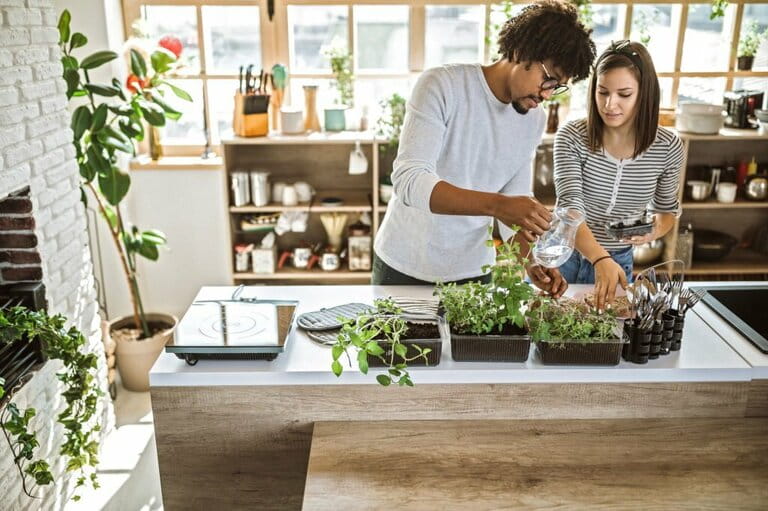Imagine being in the middle of preparing a delicious homemade meal, and you suddenly realize you're missing a crucial ingredient – fresh herbs. Instead of rushing to the grocery store or settling for dried herbs, what if you could pluck the required basil, mint, or rosemary right from your own kitchen garden? Growing herbs in your kitchen is a simple, rewarding, and sustainable way to enhance your culinary creations and infuse your home with fresh, fragrant greenery.
This comprehensive guide will walk you through the joys of growing herbs in your kitchen, even if you have limited space or gardening experience. Whether you're a seasoned green thumb or a complete beginner, cultivating herbs indoors is a fulfilling and aromatic journey.
Why Grow Herbs in Your Kitchen?
Before we delve into the intricacies of growing herbs indoors, it's essential to understand the numerous benefits of having a kitchen garden.
1. Freshness at Your Fingertips: Imagine the convenience of harvesting fresh herbs just before adding them to your dishes. The vibrant flavors and aromas are unbeatable, taking your culinary creations to a whole new level.
2. Cost-Effective: Growing herbs at home is not only cost-effective but also incredibly efficient. A small investment in herb plants or seeds can yield an abundance of herbs over time, saving you trips to the store.
3. Health Benefits: Herbs aren't just for flavor; many of them possess significant health benefits. Fresh herbs can enhance the nutritional value of your meals and contribute to your well-being.
4. Aesthetic Appeal: A mini herb garden in your kitchen adds a touch of natural beauty to your living space. It's like having living art and a functional ingredient source all in one.
5. Sustainable Living: Cultivating herbs at home reduces your carbon footprint. You won't need to purchase herbs packaged in plastic containers, reducing waste. Plus, growing your herbs can also reduce the carbon emissions associated with transporting herbs from distant locations.

How To Grow Herbs In Kitchen
Getting Started: What You'll Need
1. Suitable Containers:
The first step in starting your kitchen herb garden is selecting the right containers. Choose containers or pots with good drainage. You can repurpose small pots, use mason jars, or invest in herb-specific containers. Ensure they fit well in your kitchen space and complement your décor.
2. Herb Plants or Seeds:
Next, you have two options for starting your herb garden:
a. Herb Plants: For those who want to get started quickly, visit a local nursery or garden center to purchase young herb plants. This is the easiest and quickest way to get your garden growing.
b. Herb Seeds: If you prefer to start from scratch and watch your herbs grow from the very beginning, buy herb seeds. Herbs like basil, parsley, and chives are excellent choices for beginners.
3. Quality Potting Mix:
Selecting the right potting mix is crucial for the success of your indoor herb garden. Use a high-quality potting mix designed for container gardening. It should be well-draining to prevent waterlogged roots, which can be detrimental to your herbs.
4. Sunlight:
Most herbs thrive in bright, indirect sunlight. Place your herb containers near a south or west-facing window where they'll receive ample light. If natural light is scarce, consider using grow lights. These artificial light sources can provide your herbs with the light they need to thrive.
5. Watering Can:
You'll need a watering can with a fine spout to ensure that you can water your herbs thoroughly but without over-saturating the soil. Herbs prefer consistent moisture, not soggy soil.

Choosing the Right Herbs
While there's a wide variety of herbs you can grow indoors, some are more forgiving for beginners. Here are a few popular options:
1. Basil: Basil is a favorite herb in many kitchens, and it's relatively easy to grow. It prefers warmth and plenty of light.
2. Mint: Mint is a robust herb that can thrive in less sunlight. Be cautious, though – it can be quite invasive, so consider growing it in a separate container.
3. Chives: Chives are simple to grow and add a mild onion flavor to your dishes. They're also attractive as a windowsill herb.
4. Parsley: Parsley is a versatile herb used in various dishes. It takes a bit longer to germinate, so be patient.
5. Rosemary: Rosemary is a hardy herb but prefers a lot of sunlight. It's a great choice if you have a sunny windowsill.

Planting Your Herbs
Once you have your containers, potting mix, and chosen herbs, it's time to get your hands dirty. Here's how to plant your herbs:
Fill your containers with potting mix, leaving an inch or so at the top. Ensure the potting mix is well-draining.
Carefully remove the herb plants from their nursery pots or sow your herb seeds following the instructions on the seed packet.
Make a hole in the potting mix that's deep enough to accommodate the plant or seeds.
Place the herbs in the holes and gently press the soil around them.
Water your herbs thoroughly but avoid over-saturating the soil. Make sure the water reaches the root zone.

Caring for Your Kitchen Herbs
Cultivating a kitchen herb garden is not just about planting; it's about nurturing your herbs. Here are some care tips to ensure your herbs thrive:
Watering: Herbs don't like to sit in waterlogged soil, which can lead to root rot. Allow the top inch of the soil to dry out before watering. When you do water, do it thoroughly but avoid letting the pots stand in excess water.
Pruning: Regularly trim your herbs to encourage bushier growth and prevent them from getting leggy. When you prune your herbs, you're not only keeping them tidy but also encouraging new growth.
Feeding: During the growing season, you can use a diluted, balanced liquid fertilizer every 4-6 weeks. This provides your herbs with the essential nutrients they need to flourish.
Harvesting: Harvest your herbs when they are big enough to use but not so much that it hampers their growth. Always leave a portion of the plant for regrowth. When you harvest your herbs, do it carefully, so you don't stress the plant.

Troubleshooting Common Issues
While growing herbs indoors is generally straightforward, you may encounter a few challenges:
Pests: Keep an eye out for common pests like aphids or spider mites. Use natural remedies or insecticidal soap to keep them at bay. Frequent pruning can also help to control pests.
Disease: Overwatering can lead to root rot, while overcrowding can encourage mold or mildew. Ensure proper drainage and adequate spacing between plants to prevent these issues. Using a high-quality potting mix and sterilizing your containers can also help prevent disease.
Conclusion: Savoring the Fruits of Your Labor
With a bit of care and attention, you can enjoy a thriving herb garden right in your kitchen. The convenience of fresh herbs for your culinary creations, the aesthetic appeal of lush greenery, and the health benefits of homegrown herbs make this a rewarding endeavor. So, roll up your sleeves, get your hands in the soil, and start growing your kitchen garden today. Soon, you'll be savoring the fruits – or, in this case, herbs – of your labor in every delicious dish you create. Happy gardening!













